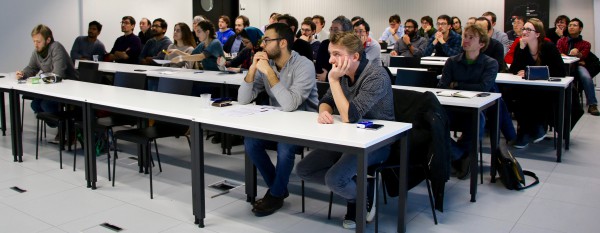MARVEL Junior Seminar — December 2016
The MARVEL Junior Seminars aim to intensify interactions between the MARVEL Junior scientists belonging to different research groups located at EPFL. The EPFL community interested in MARVEL research topics is very welcome to attend. We believe that these events will be central for establishing a vibrant community.
Each seminar consists of two presentations of 25 minutes each, allowing to present on a scientific question in depth, each presentation being followed by 10 minutes for discussion. The discussion is facilitated and timed by the chairperson of the day whose mission is to ensure active lively interactions between the audience and the speakers.
Pizza is served as of 11:45 just outside MED 2 1522 in the MED hall, and after the seminar at 13:30 you are cordially invited for coffee and dessert to continue discussion with the speakers.

MARVEL Junior Seminar Organizing Committee — Ariadni Boziki, Francesco Ambrosio, Fernando Gargiulo, Sandip De, Davide Tiana, Michele Pizzochero, Quang Van Nguyen and Nathalie Jongen
Check the list of the next MARVEL Junior Seminars in 2016-2017 here.
Abstract — Band Alignment at semiconductor-water interfaces - Zhendong Guo
A first-principles approach is demonstrated for predicting energy level alignment at semiconductor-water interfaces. Physical interface structures are sampled using density functional theory based molecular dynamics simulations. Hybrid functional (PBE0) is adapted to reproduced the experimental gaps of semiconductors. Under the neutral surface charge states, this method gives accurate estimation of band edges (e.g. CBM, VBM) of solids versus the standard hydrogen electrode (SHE), with a maximum error of 0.3 eV compared to experimental values reported.
Abstract — Analysing and Rationalising Molecular and Materials Databases Using Machine-Learning - Sandip De
Computational materials design promises to greatly accelerate the process of discovering new or more performant materials. Several collaborative efforts are contributing to this goal by building databases of structures, containing between thousands and millions of distinct hypothetical compounds, whose properties are computed by high-throughput electronic-structure calculations.
The complexity and sheer amount of information has made manual exploration, interpretation and maintenance of these databases a formidable challenge, making it necessary to resort to automatic analysis tools.
Here we will demonstrate how, starting from a measure of (dis)similarity between database items built from a combination of local environment descriptors, it is possible to apply hierarchical clustering algorithms, as well as dimensionality reduction methods such as sketchmap, to analyse, classify and interpret trends in molecular and materials databases, as well as to detect inconsistencies and errors.
Thanks to the agnostic and flexible nature of the underlying metric, we will show how our framework can be applied transparently to different kinds of systems ranging from organic molecules and oligopeptides to inorganic crystal structures as well as molecular crystals.
Low-volume newsletters, targeted to the scientific and industrial communities.
Subscribe to our newsletter